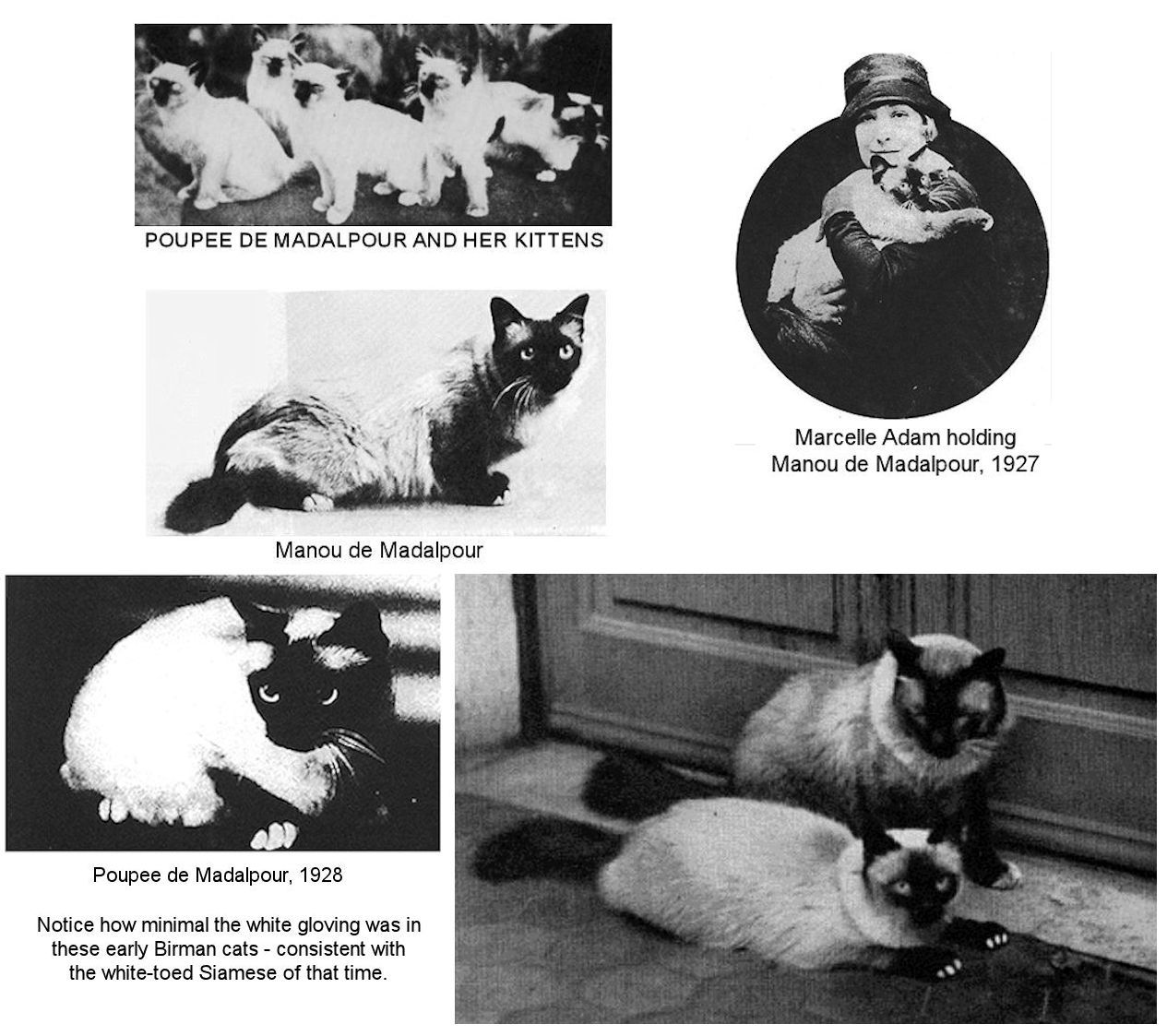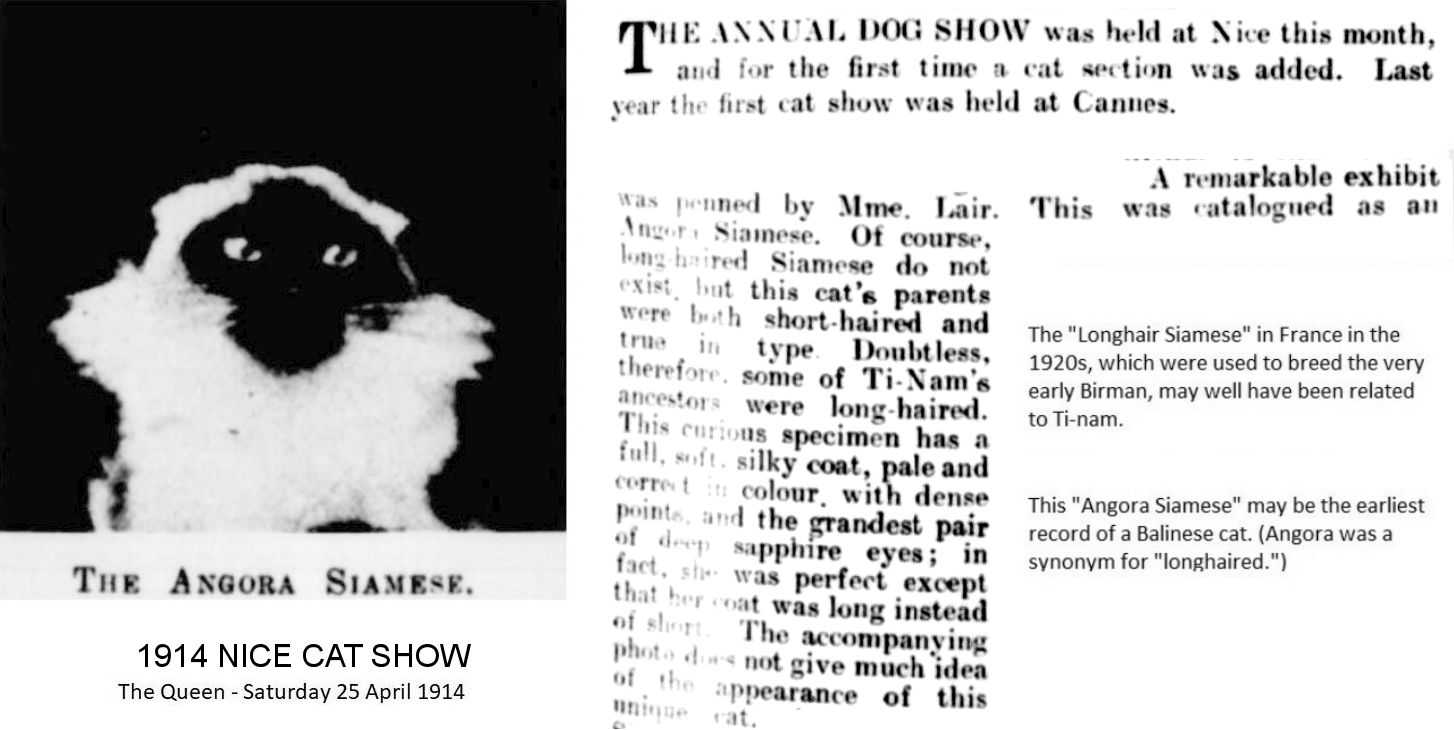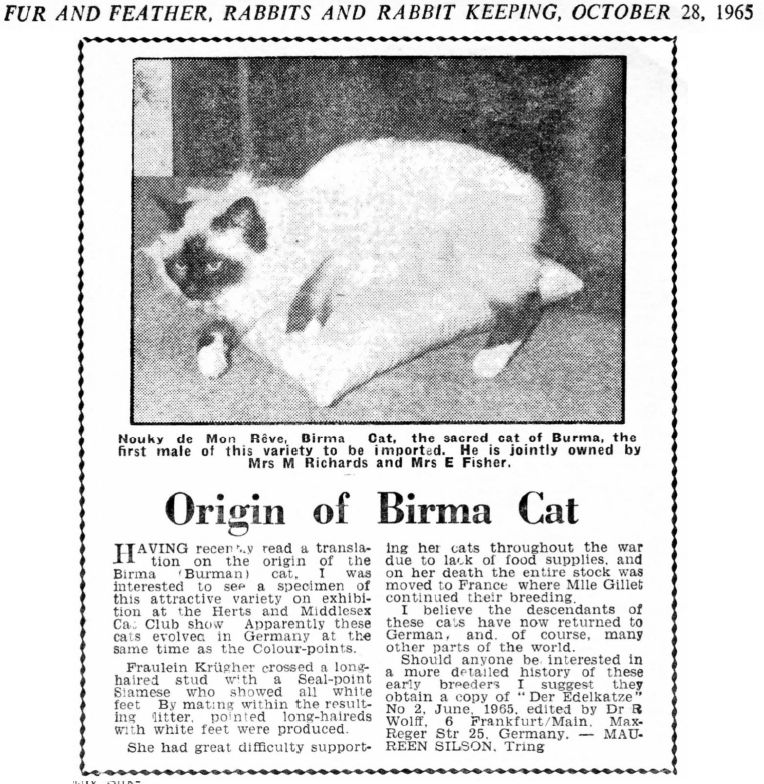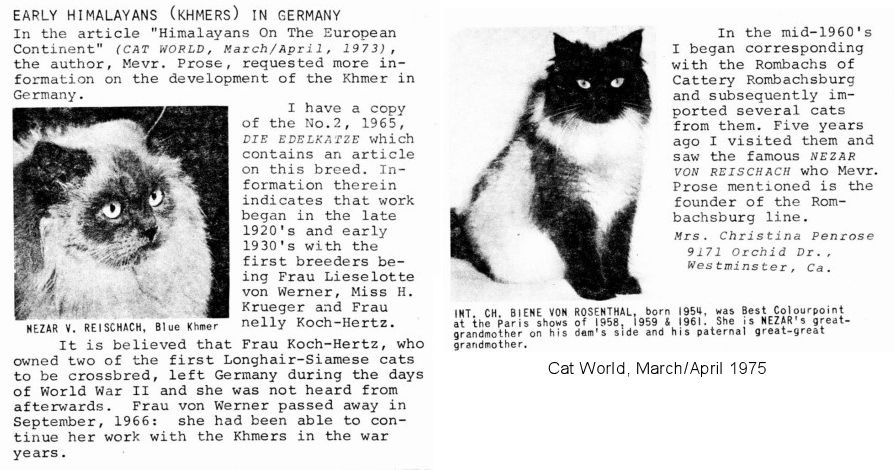
THE BIRMAN CAT – AN EARLY HISTORY
The Birman arrived in Europe around 1920 and has also been known as the Tibetan Temple Cat and the Sacred Cat of Burma. Birmans are reputedly descended from a pair, possibly stolen, brought to Europe by the millionaire Mr. Vanderbilt. It is also reported that 2 Englishmen, Major Gordon-Russell and August Pavie, then living in France, received a pair of Birmans from the Kittah people in 1919 as gratitude for their part in saving the temple from being overrun by invaders. The initial pair of Birmans are attributed to both Mr Vanderbilt and also to Mme Thadde Hadisch of Vienne, France (not Vienna, Austria) who transferred the cats to Mme Leotardi (or possibly these are 2 names for the same woman, due to remarriage). The remainder of the tale is the same: the male, Madalpour, unfortunately died during the voyage, but the female, Sita, was already pregnant. Of her kittens, it seems that only a female survived, but no males. To re-establish the type, these cats were crossed to Siamese, colourpoint shorthairs and White Longhairs.
In Cat Gossip, 26th January 1927, judge Mrs Basnett reported on the Paris Cat Show held on 14th and 15th of January by the Cat Club de France and wrote "The Sacred Burmese Temple Cats interested me very much, with their long fur on the tail and coat resembling that of a poorly bred Persian; their colouring is exactly like that of the Siamese, but their feet sometimes have white toes. I was given to understand that they are very difficult to rear, only about one in ten survive. I do not think they possess the same quick movements as the Siamese, life to them seems much more dreamy and slow, but they are very loving and intelligent." Basnett was clearly referring to the Birman although the name “Burmese Temple Cat” was also used at that time for cats analogous to modern brown Burmese. The difficulty of breeding them may relate to the difficulty of getting the correct type and markings (only 1 in 10 having the desired markings according to Mme Leotardi), although the surviving Poupee of Madalpour ("Poppet" or "Doll" of Madalpour) was bred to Siamese (or Siamese-type) cats which, at that time, had a reputation for being delicate and difficult to rear.
Leaving aside the charming myths and legends and the question of who actually obtained them, foundation female Poupee de Madalpour was born in Nice, France in 1920 and owned by Madame Leotardi. This was the first Birman born in the West. Her dam was Sita, and her sire was Madalpour, who died during importation. There are no records of any surviving siblings, making Poupee de Madalpour is the founding mother of the breed. There is no further mention of Sita, which suggests she had died. There were evidently no surviving male offspring from Sita x Madalpour, hence the need to outcross to a “Laotian Lynx” (a Siamese type cat from Laos) owned by a doctor in Nice.

According to Mme Leotardi “Birman males do not mate with Angora cats.” Leotardi had presented a “superb Persian female” to one of her Birman males. The male went into terrible rage and viciously attacked the female, but two days later he happily mated with a Chocolate Siamese (does this mean a chocolate point or a solid chocolate cat?). Leotardi did not successfully breed Angora crosses from any Birman studs, but one of her Birman females mis-mated with a Tabby Angora producing 3 shorthaired tabby males (which should not be possible from two longhaired parents) and a solid black semi-longhaired female. None of those resembled a Birman in shape. Luckily Birmans bred easily with Siamese/Laotian cats.
Poupee was likely bred to one or more Siamese (or Siamese type) males. There is a recorded litter in 1927. At that point in time the Siamese was cobbier than the modern exhibition Siamese and there was a problem of white toes appearing in the breed. This would not have been a problem for the Birman. The first Birman x Siamese offspring were probably shorthaired unless those Siamese also carried the longhair gene – something entirely possibly due to experimental breeding in England decades previously!
The “Sacre de Birmanie” was registered with the French Cat Registry in 1925. The Cat Club of France and Belgium held an international cat show in Paris in May 1926. Most exhibits were Persians and Siamese, but this show was also the public debut of the Birman breed. Three Birmans were exhibited, these being Poupee de Madalpour, her daughter Manou de Madalpour and son Hiram-Roi. In 1928, Nafaghi de Madalpour and Hiram-Roi were exhibited. In 1929, Marcel Baldwin-Crevoisier exhibited the Lon Saito (male).
Manou de Madalpour is the best known of Poupee de Madalpour’s offspring and was long-haired, unlike many of Poupee’s progeny. This means her sire carried the longhair gene. Manou was owned by Mme Marcelle Adams. Other recorded progeny of Poupee de Madalpour are: Bijou de Madalpour (shorthair female), Ijadi-Tsun de Madalpour (shorthair female), Lon-Saito de Madalpour (shorthair male), Manou de Madalpour (longhair female, b. circa 1925), Sinh de Madalpour (shorthair male, b. 1927), Lon-Golden de Madalpour (shorthair male, b. 1927), Sita I de Madalpour (shorthair female, b. 1927), Nafaghi de Madalpour (shorthair female, b. 1927), . Other early Birmans, slightly later than these, whose names we know were Moise de Madalpour (male), Bueldeda de Madalpour (female), Ubu, Djaipour, Sita III and Yadi.
For much of the early history of the breed we have to read the works of Birman breeder Monsieur Baudoin-crevoisier. In 1933, he wrote, “Poupee could not be bred by a male of that breed, but was bred to a Laotian Lynx cat belonging to a doctor in Nice. This type of cat resembles the Siamese, with very blue eyes, and this breeding produced young mongrels of Birmans and Laotians. Through successive breeding was born a perfect result – Manou de Madalpour, whose marks resemble her mother, Poupee.” In 1935, Baudoin wrote “This female [Poupee] was next bred to a male Siamese, which, at that time was baptised for the circumstances -Laotian Cat.” Investigation by Marcel Reney found that the Laotian cats were simply Siamese cats. As for the exact origin of the imported Sacred Cats of Burma, Baudoin wrote in 1935 in “Son Altesse le Chat”, “Aside from the writings of Sir Russell Gordon and Auguste Pavie, no document gives the exact origin of these cats. After six years of research and ten years breeding offspring in France, the Sacred Cat Of Burma still remains a mystery….”
As for his own breed lines, Baudoin-crevoisier admitted crossing Birman cats from the strain Madalpour with gloved Siamese and he almost certainly used Persian cats (judging by the conformation of some of his cats) although he never admitted the latter.
Manou de Madalpour is listed in the Birman databases as a female and in one account as a “magnificent seal point female” (seal-point femelle magnifique), but on many websites as a male. "Manou" ("God be with us") is a feminine name in France. The confusion is because French possessive pronouns take the gender of the object (in this case mother) not the subject (in this case Manou) so “sa mere” could mean either “her mother” or “his mother.” Manou is not recorded as having had kittens, and breeder M. Chamonin noted that the breed had fertility problems due to excessive consanguinuity. This means the Birman breed descended from Poupee’s other progeny.
In 1933, the Swiss cleric Marcel Chamonin, a breeder of Siamese cats wrote about the Birman in Revue Féline de France: "Among Birmans, unfortunately, breeders are not making progress. The great effort we made personally was not followed up. We were full of hope. [. . .] The Sacred Cat of Burma is in danger. Because of inbreeding, females are fragile and males are poor breeders. " This was a clear cry for improvement of the Birman by carefully controlled breeding. Fr. Chamonin bought two cats from Marcel Baldwin, Rose de Mogok, a daughter of Bijou de Madalpour, and Poupee de Rangoon, a daughter of Rose de Mogok. His suffix was “de la Chesnaie” and he bred the two Birman females to his (either black or blue) Persian stud “Fakir de la Chesnaie,” who was also French-bred and had gloves on all 4 paws. What the Birman needed was fresh blood to combat inbreeding depression. Interestingly, the de la Chesnaie suffix also appears in early Himalayan pedigrees. The need to outcross Birmans to other longhairs also explains the belief that Birmans were a French breed developed by crossing colourpointed cats with black-and-white bicolours.
One of the first Birmans in Germany was "Timor Madalpour", imported from France. In 1933 his picture appeared in "Die Edelkatze". Timor was mated to "Coco de Paris," resulting in a single kitten in the Lowalthardi cattery. In the 1930s, Liselotte von Werner (Alsen cattery) and Hanna Krüger (Frohnau cattery) began their Birman breedinf programmes. "Alsen von Fandango" and "Sultan von Frohnau" appear in the pedigrees of many pre-war Birmans and "Sue von Frohnau" was a prize-winner at a show in Copenhagen in 1937. These German cats would become important in re-establishing the breed in the 1940s.
In 1935, two important prefixes were registered with the Cat Club de Paris: "de Madalpour" belonging to Mlle. Chaumont-Doisy and “de Kaabaa" belonging to Mlle. Madeleine Boyer. The latter managed to keep breeding during the war.
In 1935, Baudoin-Crevoisier sold his famous Birman male Dieu d’Arakan (ancestry unrecorded) with six males and females to Princess Ratibor Hohenlohe for 30,000 French francs. The cats eventually ended up in the hands of Countess Giriode Panissera. In 1936, besides Dieu d’Arakan and Reine de Rangoon (“Queen of Rangoon”) there were 17 Birman cats and 14 kittens (mistranslations suggest 17 Birmans from 14 litters!) . At the time they were known as the most beautiful cats in the world. Others from the 1930s included Soleil d’Arakan, Bouli d’Arakan, Prince de Rangoon and Poupee de Rangoon (Mouki x Rose de Mogok). Unfortunately, a disastrous fire means that none of Dieu d’Arakan’s progeny have contributed to modern lines.
Birmans almost became extinct during World War II. Only two cats were known to be alive in Europe at the end of the war, a pair named Orloff and Xenia de Kaabaa, both belonging to Baudoin-crevoisier. These became the new foundation of the breed along with their subsequent offspring (all “de Kaabaa” suffix) and they were extensively outcrossed with other long-hairs to restore the Birman breed. Not until the early 1950s were pure Birmans being produced. In Germany a line of Birmans had been maintained by Hanna Kreuger (von Frohnau cattery) and Liselotte von Warner (von Irak cattery). Together with descendants of Orloff and Xenia these cats formed the nucleus of the post-war breeding stock.
At the same time as the Birman, the French were developing the “Khmer” from Persian x Siamese crosses and analogous to the American-bred Himalayan. These somewhat resembled the Birman in appearance, except they lacked the white gloves and boots, but are now considered to be analogous to the Himalayan.
As a result of its early near-loss and re-creation, some say the Birman comes from temples in Burma, while others claim it is a breed entirely manufactured in France using Siamese and black-and-white longhairs. French breeders had to re-create the Birman not once, but twice, first using Siamese-type shorthairs and the second time using bicolour longhairs. So is this cat really Burmese in origin or is it a French-bred replica of those cats from 1920? In 1960, a pair of "Tibetan Temple kittens" was given to a North American cat lover and were identical to the Birman cats being bred in Europe. In the early 1960's Mrs Elsie Fisher and Mrs M. Richards imported the first Birmans into Britain from France. In recent years new point colours have been introduced (but not universally recognised), including chocolate, lilac point, red, cream, tabby and tortie point. It's worth noting that the older style of Birmans tended to develop "hood-type" head colouring.
Early in the breeding of Birmans in the USA, Gertrude Griswold attempted to keep the Birman breed under her control. It was possible to adopt a female Birman from her for breeding, but to actually breed the cat, there had to be a notarized agreement (a contract with the Griswolds) that the sire would be of Gertrude Griswold's choosing and the adoption of the resulting kittens into new homes would be under her jurisdiction.


